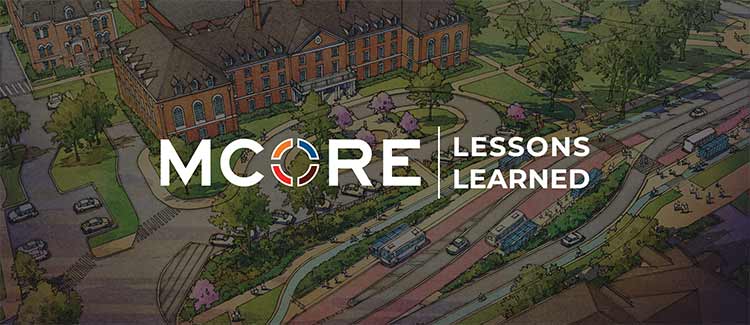Earlier this month “The MCORE Story” was presented at the 2019 APWA Illinois Chapter Conference by Clark Dietz, Hanson, City of Champaign and CU-MTD. As the project team reflects on what has been accomplished, we have identified valuable lessons learned. I hope these key takeaways can help you with any future grant pursuits. Our insights resulted from the grant application process through project development. First, let’s start with some background.
Project Background
The Multimodal Corridor Enhancement (MCORE) story begins with the efforts of the Cities of Champaign and Urbana, IL, the University of Illinois, and the Champaign-Urbana Mass Transit District. The goal was to encourage modern, urban redevelopment by creating a transportation network that is safe, efficient, and equitable for all modes. The MCORE project covered four corridors for a total of 3.5 miles. The project team explored how to serve different modes of transportation and their specific design needs throughout the varied typologies of the micro-urban University District. The project partners’ vision was supplemented with information gathered through community involvement, observation, traditional transit and traffic data, and maintenance supervisors. Modal hierarchies were established along corridors to select the proper design elements and guide the discussion between the project partners. Within the different context zones, the implemented design elements included road diets, raised bike lanes, two-stage turn boxes at intersections, bus-only lanes with level loading platforms between the bike lane and traveled way, leading pedestrian intervals, and uncontrolled mid-block crossings along pedestrian desire lines.
Pictured from left to right: Cindy Loos (Hanson Professional Services), Sean Widener (Clark Dietz), Jay Rank (CU-MTD), Chris Sokolowski (City of Champaign)
The $46.9M project was made possible with a USDOT TIGER grant award which sought to improve the existing infrastructure’s state of good repair. In doing so, this would bring economic competitiveness, enhanced quality of life, environmental sustainability, and improved safety. The MCORE project is almost complete with three of the five projects completed in 2018.
Valuable Lessons Learned:
 |
Have a firm understanding of the Notice of Funding Availability (NOFA) and identify any obligation requirements and deadlines. An aggressive schedule will require a significant commitment of agency resources. |
 |
The project description and program detail need to be specific as to what is included in the project and perhaps more importantly, what is not included in the project. Understand that if you include it, you may be required to build it. |
 |
Beware of innovative design features which may be considered experimental and require extensive before and after reporting by your agency. A lack of existing data could make reporting more difficult. |
 |
Detailed cost estimates are critical to the successful outcome of any project. Consider the time between the grant submittal and actual construction. Increases in project cost due to inflation should be accounted for. |
 |
Lastly, it is important to understand that the likelihood of receiving additional grant funds is limited after the project is awarded. Detailed cost estimates should be conservative, and your agency should have contingency plans in place such that unforeseen issues will not jeopardize the project’s completion. |
{{cta(‘ab6eb78f-38f9-44e8-ae72-c3a4808b95eb’,’justifycenter’)}}






